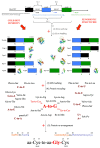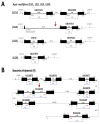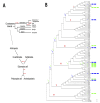Comprehensive History of CSP Genes: Evolution, Phylogenetic Distribution and Functions
- PMID: 32290210
- PMCID: PMC7230875
- DOI: 10.3390/genes11040413
Comprehensive History of CSP Genes: Evolution, Phylogenetic Distribution and Functions
Abstract
In this review we present the developmental, histological, evolutionary and functional properties of insect chemosensory proteins (CSPs) in insect species. CSPs are small globular proteins folded like a prism and notoriously known for their complex and arguably obscure function(s), particularly in pheromone olfaction. Here, we focus on direct functional consequences on protein function depending on duplication, expression and RNA editing. The result of our analysis is important for understanding the significance of RNA-editing on functionality of CSP genes, particularly in the brain tissue.
Keywords: RNA mutation; adaptive process; lipid transport; neuroplasticity; tandem duplication; xenobiotic resistance.
Conflict of interest statement
The authors declare no conflicts of interest.
Figures






Similar articles
-
Large-scale identification of odorant-binding proteins and chemosensory proteins from expressed sequence tags in insects.BMC Genomics. 2009 Dec 25;10:632. doi: 10.1186/1471-2164-10-632. BMC Genomics. 2009. PMID: 20034407 Free PMC article.
-
Molecular cloning and comparative analysis of transcripts encoding chemosensory proteins from two plant bugs, Lygus lineolaris and Lygus hesperus.Insect Sci. 2020 Jun;27(3):404-424. doi: 10.1111/1744-7917.12656. Epub 2019 Jan 15. Insect Sci. 2020. PMID: 30549241
-
Genome-Wide Analysis of Chemosensory Protein Genes (CSPs) Family in Fig Wasps (Hymenoptera, Chalcidoidea).Genes (Basel). 2020 Sep 29;11(10):1149. doi: 10.3390/genes11101149. Genes (Basel). 2020. PMID: 33003564 Free PMC article.
-
The diverse small proteins called odorant-binding proteins.Open Biol. 2018 Dec;8(12):180208. doi: 10.1098/rsob.180208. Open Biol. 2018. PMID: 30977439 Free PMC article. Review.
-
Genotyping and Bio-Sensing Chemosensory Proteins in Insects.Sensors (Basel). 2017 Aug 4;17(8):1801. doi: 10.3390/s17081801. Sensors (Basel). 2017. PMID: 28777348 Free PMC article. Review.
Cited by
-
Gene transcription changes in a locust model of noise-induced deafness.J Neurophysiol. 2021 Jun 1;125(6):2264-2278. doi: 10.1152/jn.00119.2021. Epub 2021 May 5. J Neurophysiol. 2021. PMID: 33949886 Free PMC article.
-
Molecular mechanisms of olfactory detection in insects: beyond receptors.Open Biol. 2020 Oct;10(10):200252. doi: 10.1098/rsob.200252. Epub 2020 Oct 7. Open Biol. 2020. PMID: 33022193 Free PMC article.
-
Lactobacillus for ribosome peptide editing cancer.Clin Transl Oncol. 2023 Jun;25(6):1522-1544. doi: 10.1007/s12094-022-03066-5. Epub 2023 Jan 24. Clin Transl Oncol. 2023. PMID: 36694080 Free PMC article. Review.
-
Comparison and Functional Analysis of Odorant-Binding Proteins and Chemosensory Proteins in Two Closely Related Thrips Species, Frankliniella occidentalis and Frankliniella intonsa (Thysanoptera: Thripidae) Based on Antennal Transcriptome Analysis.Int J Mol Sci. 2022 Nov 11;23(22):13900. doi: 10.3390/ijms232213900. Int J Mol Sci. 2022. PMID: 36430376 Free PMC article.
-
Coexpression of Three Odorant-Binding Protein Genes in the Foreleg Gustatory Sensilla of Swallowtail Butterfly Visualized by Multicolor FISH Analysis.Front Insect Sci. 2021 Jul 30;1:696179. doi: 10.3389/finsc.2021.696179. eCollection 2021. Front Insect Sci. 2021. PMID: 38468877 Free PMC article.
References
-
- Nomura A., Kawasaki K., Kubo T., Natori S. Purification and localization of p10, a novel protein that increases in nymphal regenerating legs of Periplaneta americana (American cockroach) Int. J. Dev. Biol. 1992;36:391–398. - PubMed
-
- Picimbon J.F., Leal W.S. Olfactory soluble proteins of cockroaches. Insect Biochem. Mol. Biol. 1999;30:973–978. doi: 10.1016/S0965-1748(99)00073-9. - DOI
-
- Angeli S., Ceron F., Scaloni A., Monti M., Monteforti G., Minnocci A., Petacchi R., Pelosi P. Purification, structural characterization, cloning and immunocytochemical localization of chemoreception proteins from Schistocerca gregaria. Eur. J. Biochem. 1999;262:745–754. doi: 10.1046/j.1432-1327.1999.00438.x. - DOI - PubMed
Publication types
MeSH terms
Substances
LinkOut - more resources
Full Text Sources

